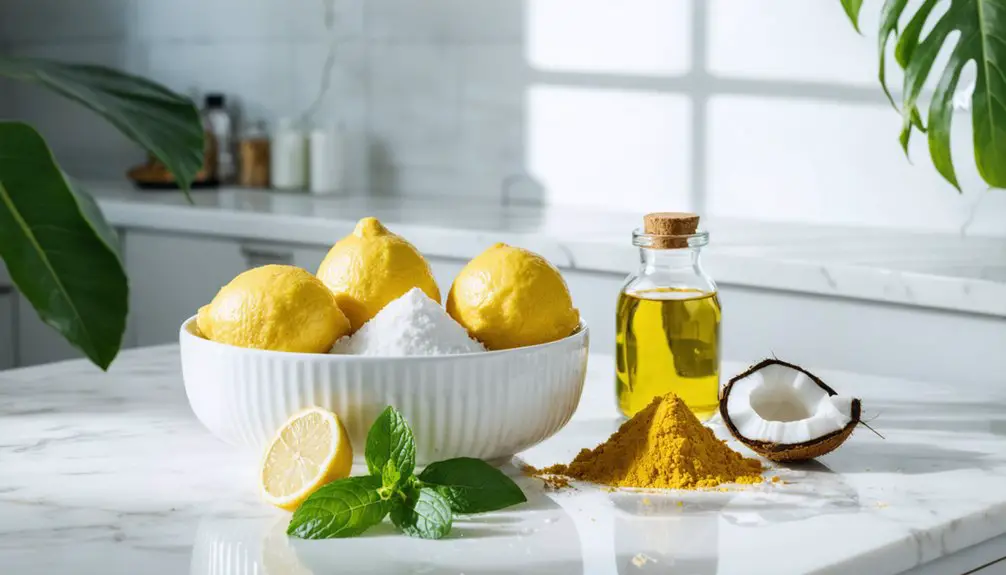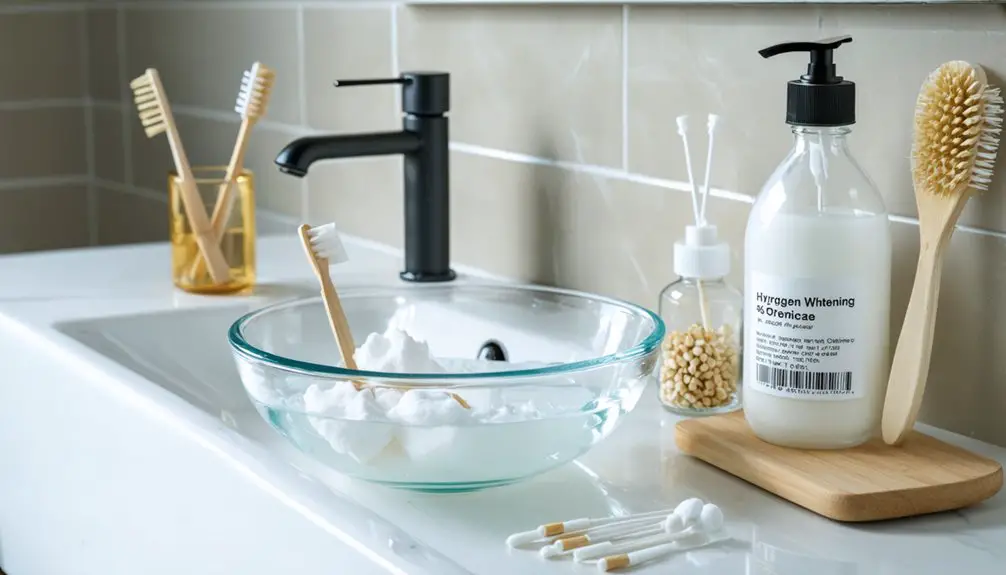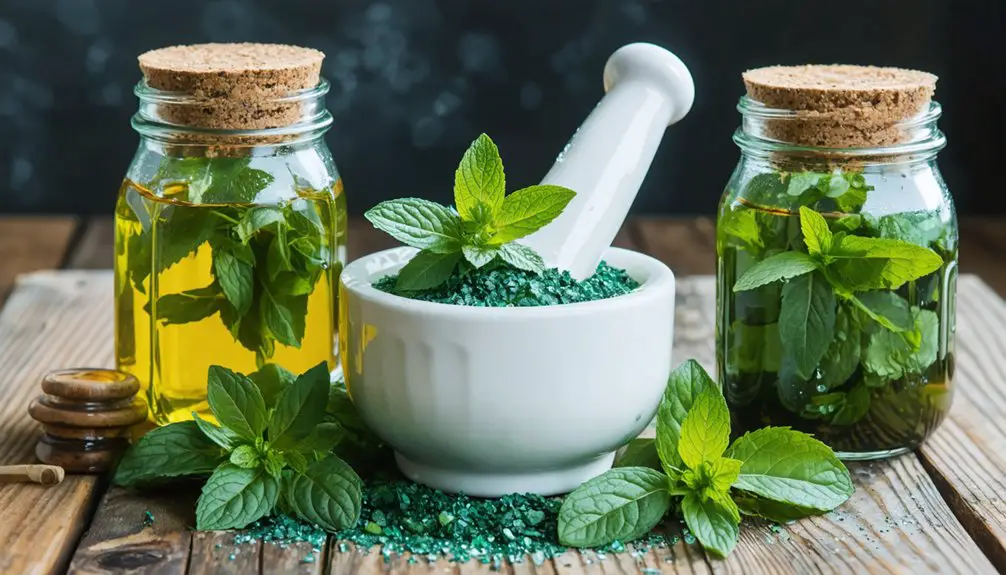You can safely whiten your teeth at home using several natural methods. Mix baking soda with water to create a gentle whitening paste, or try oil pulling with coconut oil for 15-20 minutes daily. Eating crunchy fruits and vegetables like apples, carrots, and celery helps scrub away surface stains naturally. Remember to brush twice daily and rinse after consuming staining beverages. These proven techniques offer gradual but lasting results when properly implemented.
Key Takeaways
- Mix baking soda with water to create a natural whitening paste and apply gently in circular motions 1-2 times weekly.
- Practice oil pulling with coconut oil for 15-20 minutes daily to reduce surface stains and improve oral health.
- Eat crunchy fruits and vegetables like apples, carrots, and celery to naturally scrub teeth and remove surface stains.
- Rinse mouth immediately with water after consuming staining beverages and use a straw when drinking coffee or wine.
- Combine strawberries with baking soda for a natural whitening treatment, as they contain malic acid for teeth brightening.
Safe and Effective Uses of Baking Soda for Teeth Whitening
While baking soda has gained popularity as a natural teeth whitening solution, understanding its proper use is essential for safe and effective results.
Research shows that gentle abrasive action helps whiten teeth safely over time. You’ll find several baking soda benefits, including its ability to remove surface stains through gentle abrasion and neutralize harmful acids in your mouth.
To minimize baking soda risks, limit applications to 1-2 times weekly. You can create a simple paste by mixing baking soda with water, or combine it with your regular fluoride toothpaste for enhanced protection. Studies show that mixing with hydrogen peroxide can produce superior whitening results compared to regular toothpaste.
Keep teeth safe by using baking soda treatments just once or twice weekly, mixed with water or regular toothpaste.
When applying, use gentle circular motions rather than vigorous brushing to protect your enamel.
While it’s not as potent as professional whitening treatments, baking soda’s natural antibacterial properties help reduce plaque and freshen breath while gradually improving tooth color through consistent, moderate use.
Natural Fruits and Foods That Help Brighten Your Smile
Beyond household remedies like baking soda, your diet plays a key role in maintaining bright, healthy teeth. The fruit benefits of apples and strawberries stem from their high malic acid content, which naturally cleanses and whitens teeth while increasing saliva production. These fruits contain natural teeth-whitening agents that help maintain a brighter smile. Regular consumption of oranges can help break down plaque naturally.
Both fruits effectively remove surface stains and support ideal oral health.
Your vegetable choices can greatly impact tooth brightness. Carrots and celery act as natural scrubbers, removing plaque while stimulating saliva flow that neutralizes harmful acids.
These crunchy vegetables provide essential vitamins A and C, strengthening enamel and promoting gum health.
Additional options like broccoli, cauliflower, and watermelon contribute to teeth whitening through their fibrous textures and natural cleaning properties, making them excellent choices for maintaining a brighter smile naturally.
Traditional Methods: Oil Pulling and Plant-Based Solutions
Although oil pulling has roots in ancient Ayurvedic medicine, scientific evidence supporting its tooth-whitening capabilities remains limited.
When you practice oil pulling, you’ll swish plant-based oils like coconut, sesame, or sunflower in your mouth for 15-20 minutes. While this method may help reduce surface stains through mechanical cleaning action, it doesn’t actually whiten your teeth’s enamel. The American Dental Association has not endorsed oil pulling as an effective oral health practice.
Coconut oil contains antimicrobial properties and shows the most promise among plant-based oils for oral health benefits. Relying solely on oil pulling could lead to delayed dental treatment and worsening oral health conditions.
However, you shouldn’t rely on oil pulling as your primary whitening solution. Clinical studies indicate that traditional dental whitening procedures deliver more predictable results.
If you choose to try oil pulling, remember it’s best used as a complement to, not a replacement for, proper dental care and hygiene practices.
Daily Habits to Maintain Whiter Teeth Naturally
Since maintaining whiter teeth requires consistent daily effort, establishing proper habits can greatly impact your smile’s brightness over time. Effective teeth brushing with fluoride-based whitening toothpaste twice daily, coupled with proper flossing techniques, forms the foundation of natural whitening maintenance. Enjoying a cheese-rich meal can help promote whiter teeth naturally.
Complement these practices by rinsing your mouth with water after consuming staining beverages and using a straw when drinking coffee, tea, or wine. Incorporating crunchy fruits and vegetables into your diet can help naturally clean your teeth while promoting overall oral health.
- Brush for two minutes each session, paying special attention to the gumline where stains often accumulate.
- Practice daily flossing at night to remove plaque and prevent yellowing between teeth.
- Wait 30 minutes after acidic foods before brushing to protect your enamel’s integrity.
Your consistent adherence to these practices will help preserve your teeth’s natural whiteness while protecting oral health.
When to Choose Natural Remedies vs. Professional Treatment
When deciding between natural remedies and professional teeth whitening, you’ll need to contemplate the type and severity of your tooth discoloration.
Natural remedies work best for surface-level stains from food, drinks, or smoking, offering a gentle approach for those with sensitive teeth or budget constraints. You’ll see gradual improvements with consistent use, making them ideal for maintenance after other treatments. Professional-grade treatments contain higher concentrations of peroxide-based bleaching agents for more effective results.
Natural whitening methods provide a cost-effective, gentle solution for everyday stains while helping maintain results from professional treatments.
Professional whitening becomes essential for deep, intrinsic stains caused by aging, trauma, or medications. If you need immediate results for a special event or have dental restorations, a professional treatment’s higher concentration of bleaching agents will deliver uniform, dramatic results. A dentist will create custom-fitted trays to ensure even application and optimal results.
Though costlier upfront ($300-$1,000+), professional whitening provides lasting brightness for up to three years and includes supervised care to minimize sensitivity.
Frequently Asked Questions
Can Whitening Toothpaste Be Combined With Natural Remedies Safely?
You’ll need to carefully evaluate toothpaste ingredients before combining with natural remedies. For safe whitening effectiveness, limit abrasive combinations and avoid acidic natural treatments. Consult your dentist for personalized guidance.
How Long Should I Wait Between Different Natural Whitening Treatments?
You should wait 3-4 days between natural whitening treatments, using them once or twice weekly. This whitening frequency protects your enamel while ensuring effective treatment duration and minimizing sensitivity risks.
Do Medications Affect the Effectiveness of Natural Teeth Whitening Methods?
Yes, your medications can greatly impact natural whitening effectiveness and dental health. You’ll need professional guidance to address medication interactions and guarantee safe whitening methods for your specific situation.
Can Natural Whitening Methods Remove Deep Stains From Antibiotics or Fluorosis?
You won’t achieve significant results with natural methods for antibiotic stains or fluorosis removal. These deep, intrinsic stains require professional treatments with peroxide compounds that can penetrate your enamel’s structure.
Are Natural Whitening Methods Safe During Pregnancy and Breastfeeding?
While natural whitening methods pose fewer safety concerns than chemical treatments during pregnancy, you’ll still need to consult your dentist first, as pregnancy effects can make teeth and gums more sensitive.
References
- https://pmc.ncbi.nlm.nih.gov/articles/PMC10024105/
- https://pmc.ncbi.nlm.nih.gov/articles/PMC9645194/
- https://www.luriedental.com/dental-services/cosmetic/blog/do-natural-teeth-whitening-remedies-really-work
- https://www.dentistryformidtown.com/blog/natural-teeth-whitening-remedies-separating-fact-from-fiction/
- https://www.medicalnewstoday.com/articles/322421
- https://southeasterndentalcenter.com/baking-soda-a-natural-solution-for-whiter-teeth/
- https://ubiehealth.com/doctors-note/baking-soda-teeth-whitening-effectiveness
- https://www.healthline.com/health/baking-soda-toothpaste
- https://www.todaysrdh.com/what-the-research-shows-regarding-the-efficacy-of-dental-whitening-options/
- https://www.sendhildental.com/12-fruits-and-vegetables-to-snack-your-way-to-whiter-teeth/



